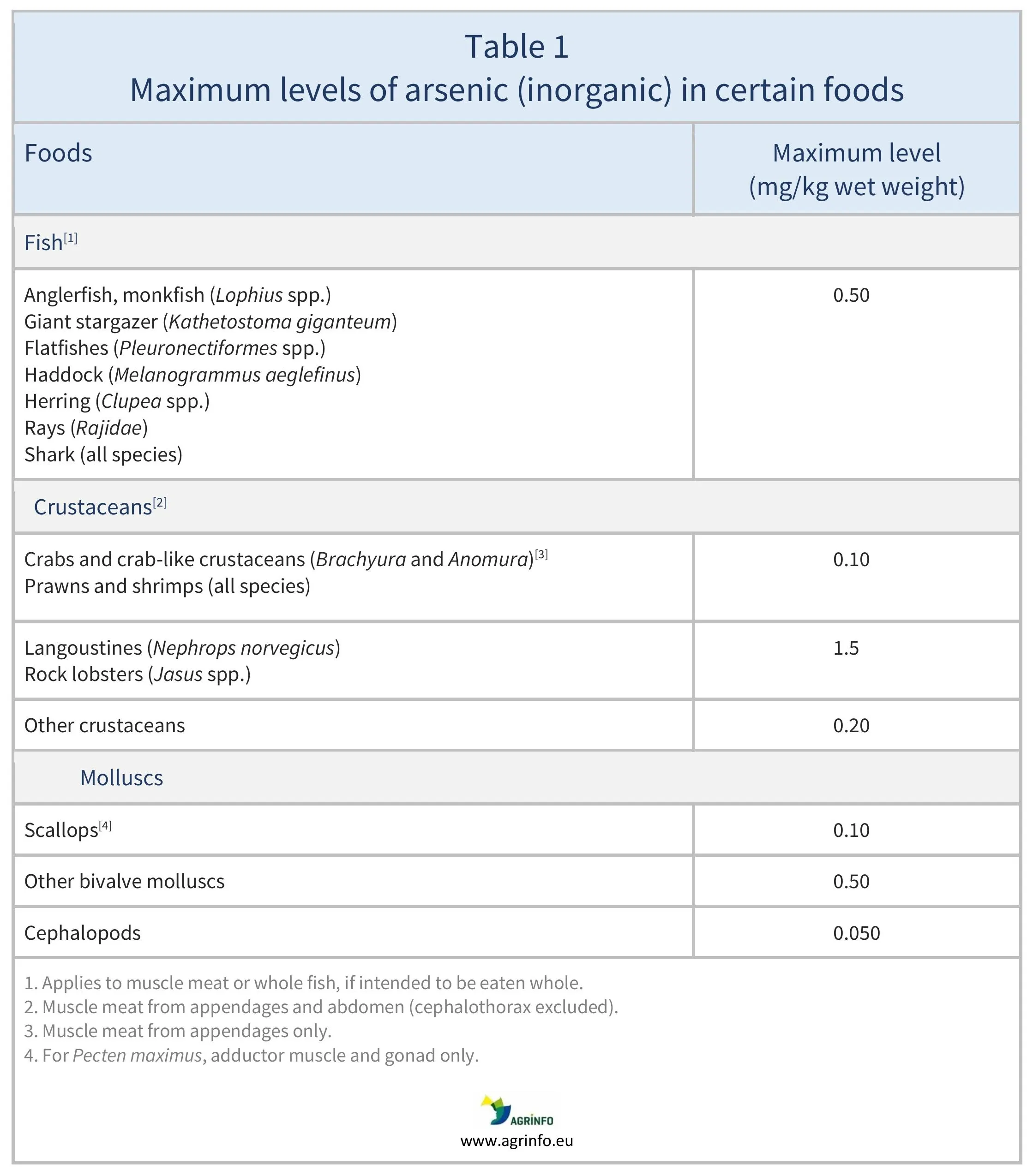Maximum levels of inorganic arsenic in fish and seafood
- Contaminants
- Food safety
Summary
The European Commission has adopted maximum levels for inorganic arsenic in fish and certain other seafood.
EU adopts maximum levels of inorganic arsenic in fish and seafood
Commission Regulation (EU) 2025/1891 of 17 September 2025 amending Regulation (EU) 2023/915 as regards maximum levels of inorganic arsenic in fish and other seafood
Update
The European Commission has adopted maximum levels for inorganic arsenic in fish and certain other seafood.
Impacted Products
Fish, seafood
What is changing?
The European Union (EU) has adopted maximum levels for inorganic arsenic in certain fish, crustaceans, bivalves, and cephalopods. The maximum levels are shown in Table 1. This amends Regulation 2023/915.
Why?
The European Food Safety Authority has updated its earlier risk assessment of chronic dietary exposure to inorganic arsenic in food (EFSA 2021, 2024). EFSA concludes that the current exposure to inorganic arsenic continues to raise health concerns for consumers. The consumption of fish and certain other seafoods contribute to that exposure. EFSA recommends maximum levels of inorganic arsenic for those products.
Timeline
The Regulation enters into force on 7 October 2025.
What are the major implications for exporting countries?
Suppliers of fish and certain other seafood to the EU market will need to add arsenic to the list of contaminants subject to analysis, to ensure compliance with new maximum levels.
Recommended Actions
Exporters should review existing levels of arsenic in fish and seafood intended for the EU market and, if levels exceed the EU’s proposed limits, seek to identify and isolate sources of contamination. Information on recommended methods and performance criteria for analysis of arsenic in foodstuffs can be found in Regulation 2016/582.
Background
Arsenic is present at low concentrations in rocks, soil, and natural groundwater. Human activity, including mining and burning of fossil fuels, and the use of fertilisers and pesticides containing arsenic, has contributed to increasing levels of arsenic in the environment. Humans are mostly exposed to arsenic through food and drinking water.
Inorganic arsenic is associated with lung, bladder, and skin cancers. EFSA (2021) assessed the chronic dietary exposure of the European population to inorganic arsenic, and confirmed that terrestrial foods – particularly rice, rice-based products, grains and grain-based products, and drinking water – remain the main contributors to exposure (see Maximum levels of arsenic in certain foods). It also identified fish and other seafood as sources of exposure for the adult population in certain countries.
Resources
EFSA (2021) Chronic dietary exposure to inorganic arsenic. EFSA Journal, 19(1): 638.
EFSA (2024) Update of the risk assessment of inorganic arsenic in food. EFSA Journal, 22(1): e8488.
Commission Regulation (EU) 2023/915 on maximum levels for certain contaminants in food
Sources
Commission Regulation (EU) 2025/1891 as regards maximum levels of inorganic arsenic in fish and other seafood
Tables & Figures

Source: based on Annex to Regulation 2025/1891
Disclaimer: Under no circumstances shall COLEAD be liable for any loss, damage, liability or expense incurred or suffered that is claimed to have resulted from the use of information available on this website or any link to external sites. The use of the website is at the user’s sole risk and responsibility. This information platform was created and maintained with the financial support of the European Union. Its contents do not, however, reflect the views of the European Union.
EU adopts maximum levels of inorganic arsenic in fish and seafood
Commission Regulation (EU) 2025/1891 as regards maximum levels of inorganic arsenic in fish and other seafood
What is changing and why?
The European Union (EU) has adopted maximum levels for inorganic arsenic in fish and certain other seafood (see Table 1). This is because a risk assessment by the European Food Safety Authority has concluded that current exposure to inorganic arsenic continues to pose a risk of lung, bladder, and skin cancers for consumers.
Actions
Exporters should review existing levels of arsenic in fish and seafood intended for the EU market and, if levels exceed the EU’s proposed limits, seek to identify and isolate sources of contamination. Information on recommended methods and performance criteria for analysis of arsenic in foodstuffs can be found in Regulation 2016/582.
Timeline
The Regulation enters into force on 7 October 2025.
Tables & Figures

Source: based on Annex to Regulation 2025/1891
Disclaimer: Under no circumstances shall COLEAD be liable for any loss, damage, liability or expense incurred or suffered that is claimed to have resulted from the use of information available on this website or any link to external sites. The use of the website is at the user’s sole risk and responsibility. This information platform was created and maintained with the financial support of the European Union. Its contents do not, however, reflect the views of the European Union.
